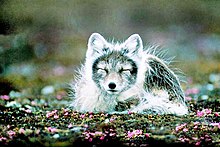Red foxes force shrinkage of arctic fox territory
In the Arctic there has been a change in the distribution of both red and arctic foxes. Red foxes have expanded their territory to the North as the climate has warmed, at the expense of arctic foxes.
Due to a lack of observations of interactions between the two fox species, biologists have been unsure whether the loss of arctic fox territory was due to direct competition, or if they were indirectly competing for the same food. Rodnikova et al have now reported observing a red fox intruding upon a arctic fox den in 2007.
Researchers were working along the Yamal Peninsula in Russia in an area with twelve known arctic fox breeding dens. A red fox, in poor condition, made its way to one den's entrance and went inside. About thirty minutes later an arctic fox also approached the den, keeping against the wind and moving hesitantly, until lying down to watch the den, approximately 50m away.
When the red fox emerged later it lay on top of the den while the arctic fox barked at it for ten minutes. When the observer got closer the red fox went back into the den, but soon returned and starting the arctic fox barking once more. This continued until the observer left; when they returned, three hours later, the red fox was seen leaving but there was no sign of the arctic fox. Subsequent visits to the area showed no more foxes and no sign of the eight pups that been seen three days earlier.
This observation is the first sign of direct competition between the two fox species, although the researchers believe that the pups managed to hide in the den (which had eight known entrances and spanned 110 square-metres) and subsequently abandoned it.
Although red foxes and arctic foxes have been known to co-exist peacefully, it is also known that red foxes will sometimes kill arctic foxes even in farm conditions. This causes problems for arctic foxes who are almost never dominant against red foxes which are 25% bigger. Even here, when the arctic fox has a den and cubs, she was not prepared to fight the red fox.
Read more: A summary of the paper with quotes from the researchers is available from the BBC.

About the author
Rakuen Growlithe — read stories — contact (login required)a scientist and Growlithe, interested in science, writing, pokemon and gaming
I'm a South African fur, originally from Cape Town, who spends most of his time in Europe. I'm interested in all sorts of things, particularly science, furry and some naughtier things too!

Comments
[comment removed on request]
The fox in question appears to be wearing its summer coat, which is largely brown.
You changed the picture. :( I was wondering if you thought this would work here or not, glad to see it made it.
It's a bit disappointing they have summer coats with cubs. When you think arctic fox you imagine a cute, white fluffball. There was an article on arctic foxes in the National Geographic a few years back which had a bunch of pics of both coats. Summer coats just look messy.
"If all mankind minus one, were of one opinion, and only one person were of the contrary opinion, mankind would be no more justified in silencing that one person, than he, if he had the power, would be justified in silencing mankind."
~John Stuart Mill~
Well, the other one had the summer coat too. :-)
It may be messy, but it means they get to eat. That's worth looking a bit ugly.
>you would never be able to watch "Fox and the Hound" again, without realizing what a bastard Tod really is inside
I'm okay with this.
Post new comment